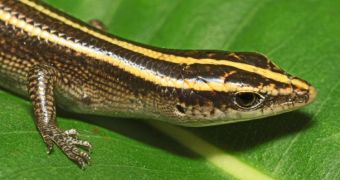The copper striped blue-tailed skink (Emoia impar) is now extinct from the Hawaiian Archipelago, researchers at the United States Geological Survey (USGS) announce. The lizard represents the latest native vertebrate to disappear from its original, tropical habitat.
The sleek creature had smooth, polished scales and a long, sky-blue tail, researchers say. The last living one was found by a survey conducted in the 1960s, on the Na’Pali coast of Kauai. Since then, a number of field tests failed to find any living specimen.
Scientists scoured the Kauai, Oahu, Maui and Hawai’i islands at regular intervals, between 1988 and 2008. During these investigations, the teams did not even manage to see a representative of this skink species, let alone capture one for study.
According to experts, extinctions are unfortunately not at all uncommon in the archipelago. In fact, it could be that it is one of the most severely affected habitats in the world, in terms of encroaching human influence.
“No other landscape in these United States has been more impacted by extinction events and species invasions in historic times than the Hawaiian Islands, with as yet unknown long-term cascading consequences to the ecosystem,” explains Marcia McNutt.
“Today, we close the book on one more animal that is unlikely to ever be re-established in this fragile island home,” adds the expert, who holds an appointment as the director of the USGS.
“This skink was once common throughout the Hawaiian Islands, and in fact the species can still be found on many other island groups in the tropical Pacific,” USGS Western Ecological Research Center biologist Robert Fisher says.
He adds that this is one of the main reasons why the recently-confirmed extinction is so weird. The creature was very common and widespread, and yet it only disappeared on Kauai, and no other islands.
Details of the new investigation appear in the latest issue of the international conservation journal Oryx, which is published by Fauna and Flora International. Scientist Ivan Ineich, from the Muséum national d’Histoire naturelle, in Paris, was also a part of the research group.
“There's some evidence that an invasive ant was preying on these skinks. That's a new factor we'll need to examine as we look out for other at-risk species in the Pacific islands,” Fisher explains.

 14 DAY TRIAL //
14 DAY TRIAL //